Related Research Articles

The toonie, formally the Canadian two-dollar coin, was introduced on February 19, 1996, by Minister of Public Works Diane Marleau. As of 2023, it possesses the highest monetary value of any circulating Canadian coin. The toonie is a bi-metallic coin which on the reverse side bears an image of a polar bear by artist Brent Townsend. The obverse, since 2023, bear a portrait of King Charles III. It has the words CHARLES III / D.G. REX; before 2023, the words were in a typeface different to other Canadian coins.

The Australian dollar is the official currency and legal tender of Australia, including all of its external territories, and three independent sovereign Pacific Island states: Kiribati, Nauru, and Tuvalu. In April 2022, it was the sixth most-traded currency in the foreign exchange market and as of Q4 2023 the seventh most-held reserve currency in global reserves.

The British decimal ten pence coin is a denomination of sterling coinage worth 1⁄10 of a pound. Its obverse has featured the profile of Queen Elizabeth II since the coin's introduction in 1968, to replace the florin coin in preparation for decimalisation in 1971. It remained the same size as the florin until a smaller version was introduced on 30 September 1992, with the older coins being withdrawn on 30 June 1993. Four different portraits of the Queen have been used on the coin; the latest design by Jody Clark was introduced in 2015. The second and current reverse, featuring a segment of the Royal Shield, was introduced in 2008.

The British one pound (£1) coin is a denomination of sterling coinage. Its obverse bears the Latin engraving ELIZABETH II D G REG F D meaning, 'Elizabeth II, by the grace of God, Queen, Defender of the Faith'. It has featured the profile of Queen Elizabeth II since the original coin's introduction on 21 April 1983. Four different portraits of the Queen have been used, with the latest design by Jody Clark being introduced in 2015. The design on the reverse side of the current, 12-sided coin features four emblems to represent each of the nations of the United Kingdom — the English rose, the leek for Wales, the Scottish thistle, and the shamrock for Northern Ireland, also two or three oak leaves — emerging from a single 5-branched stem within a crown. In May 2022 the Royal Mint announced that the Kenyan-born artist Michael Armitage is designing a new £1 coin which will be issued in 2023 and will celebrate the "history of the UK in the 21st century".

The krone is the official currency of Denmark, Greenland, and the Faroe Islands, introduced on 1 January 1875. Both the ISO code "DKK" and currency sign "kr." are in common use; the former precedes the value, the latter in some contexts follows it. The currency is sometimes referred to as the Danish crown in English, since krone literally means crown. Krone coins have been minted in Denmark since the 17th century.
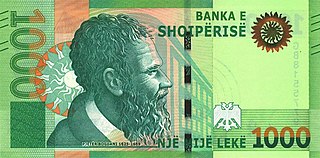
The lek is the currency of Albania. Historically, it was subdivided into 100 qintars.

The Royal Canadian Mint is the mint of Canada and a Crown corporation, operating under the Royal Canadian Mint Act. The shares of the Mint are held in trust for the Crown in right of Canada.
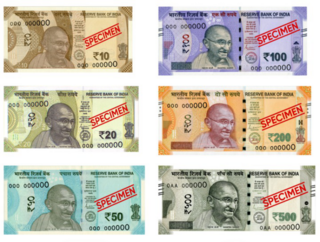
The Indian rupee is the official currency in India. The rupee is subdivided into 100 paise. The issuance of the currency is controlled by the Reserve Bank of India. The Reserve Bank manages currency in India and derives its role in currency management based on the Reserve Bank of India Act, 1934.

The ngultrum is the currency of the Kingdom of Bhutan. It can be literally translated as 'silver' for ngul and 'coin' for trum. It is subdivided into 100 chhertum. The Royal Monetary Authority of Bhutan, the central bank of Bhutan is the minting authority of the ngultrum banknotes and coins. The ngultrum is currently pegged to the Indian rupee at parity.

The Royal Australian Mint is the national mint of Australia, and the primary production facility for the country’s circulating coins. The mint is a Commonwealth Government entity operating within the portfolio of the Treasury, and is situated in the Australian capital city of Canberra, in the suburb of Deakin. The current facility was opened in 1965 by Prince Philip, Duke of Edinburgh.

The som is the currency of Kyrgyzstan.

The Cook Islands dollar was the former currency of the Cook Islands, which now uses the New Zealand dollar, although some physical cash issued for the Cook Islands dollar remains in use. The dollar was subdivided into 100 cents, with some older 50-cent coins carrying the denomination as "50 tene".
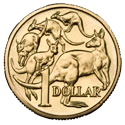
The Australian one-dollar coin is the second most valuable circulation denomination coin of the Australian dollar after the two-dollar coin; there are also non-circulating legal-tender coins of higher denominations.
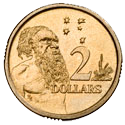
The Australian two-dollar coin is the highest-denomination coin of the Australian dollar. It was first issued on 20 June 1988, having been in planning since the mid-1970s. It replaced the Australian two-dollar note due to having a longer circulatory life. The only "mint set only" year was 1991.
The coins of the Australian dollar were introduced on 14 February 1966, although they did not at that time include the one-dollar or two-dollar coins. The dollar was equivalent in value to 10 shillings in the former currency.
The National Front's election results in parliamentary elections are shown below.
Coins of the Australian dollar are circulated with different designs depicting various anniversaries or significant Australian events, these differing coin designs being labelled Australian commemorative coins. Typically, only the 20c, 50c, $1 and $2 coins have been minted in commemoration.
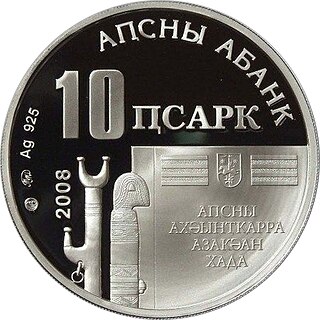
The apsar is a currency of Abkhazia. So far, coins in denominations of 1, 2, 3, 5, 10, 20, 25, 50, and 100 apsars and banknotes in denominations of 10, 25, 100, and 500 apsars have been issued. While the coins and banknotes are legal tender in the Republic of Abkhazia, their usage is very limited, and they are mostly made for collectors. In Abkhazia, the Russian ruble is used in practice. The first apsar coins were introduced in 2008.
Prior to European colonization, early Aboriginal Australian communities traded using items such as tools, food, ochres, shells, raw materials and stories, although there is no evidence of the use of currencies.
References
- 1 2 www.australianbanknotes.net - R516
- 1 2 www.australianbanknotes.net – R416
- 1 2 www.australianbanknotes.net – R316a
- 1 2 www.australianbanknotes.net – R616
- ↑ "Frequently Asked Questions". Royal Australian Mint. 5 January 2016. Retrieved 5 April 2023.
- ↑ Knowles, Rachael (5 April 2023). "The remarkable life of the Warlpiri-Anmatyerre man on the $2 coin". NITV . SBS . Retrieved 5 April 2023.
- 1 2 3 4 www.australianbanknotes.net – R33
- 1 2 www.australianbanknotes.net - R71
- 1 2 King Charles III now on Australian coins, Treasury, retrieved 16 January 2024
- ↑ www.australianbanknotes.net – R214
- 1 2 3 www.australianbanknotes.net - R202
- ↑ "Minister releases circulating wedding coin for all Australians" (Press release). Royal Australian Mint. 12 April 2011. Retrieved 2 June 2011. (Archived by WebCite at https://www.webcitation.org/5yKAuROta)
- ↑ Rogers, Kerry (15 June 2011). "Royal Fans Exchange Old Coins for New". World Coin News. Retrieved 11 July 2011. (Archived by WebCite at https://www.webcitation.org/6052U9C8p)
- 1 2 3 www.australianbanknotes.net - R505
- 1 2 www.australianbanknotes.net - R22a
- ↑ www.australianbanknotes.net - R57
- 1 2 www.australianbanknotes.net – R29
- 1 2 www.australianbanknotes.net - R45
- 1 2 www.australianbanknotes.net - R49
- 1 2 www.australianbanknotes.net – R12
- 1 2 3 www.australianbanknotes.net - R81
- 1 2 3 www.australianbanknotes.net – R301
- 1 2 3 www.australianbanknotes.net – R401
- 1 2 3 www.australianbanknotes.net – R608
- ↑ www.australianbanknotes.net – R310a
- 1 2 www.australianbanknotes.net – R28
- ↑ www.australianbanknotes.net – R9
- ↑ www.australianbanknotes.net - R44a
- ↑ www.australianbanknotes.net – R16
- ↑ www.australianbanknotes.net – R4
- ↑ www.australianbanknotes.net - R38a
- ↑ www.australianbanknotes.net - R55
- ↑ www.australianbanknotes.net - R58
- ↑ £10 note
- 1 2 www.australianbanknotes.net – R219
- ↑ www.australianbanknotes.net - R62
- ↑ The Numismatist Volume 105 (1992). American Numismatic Association. 1992. p. 945.